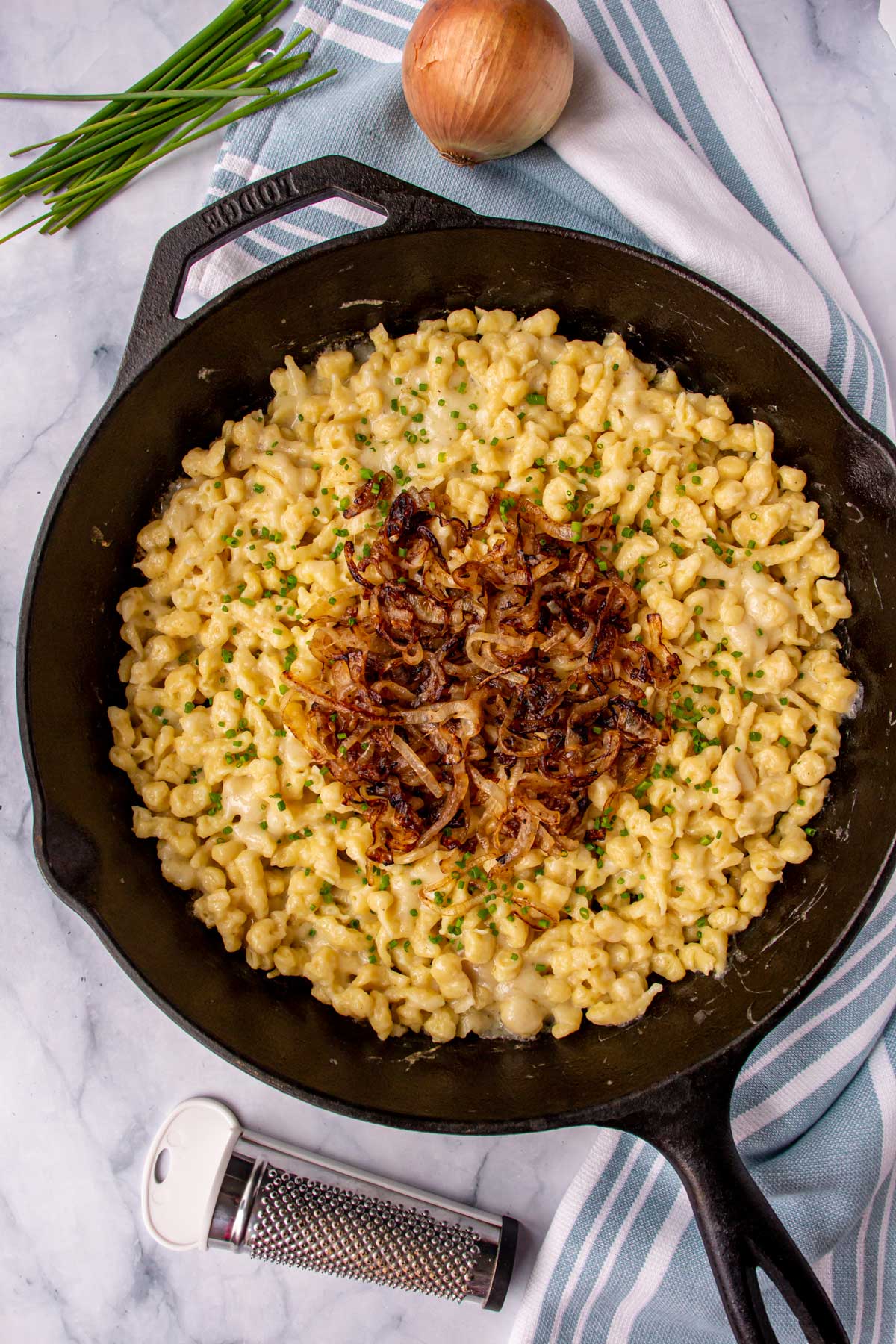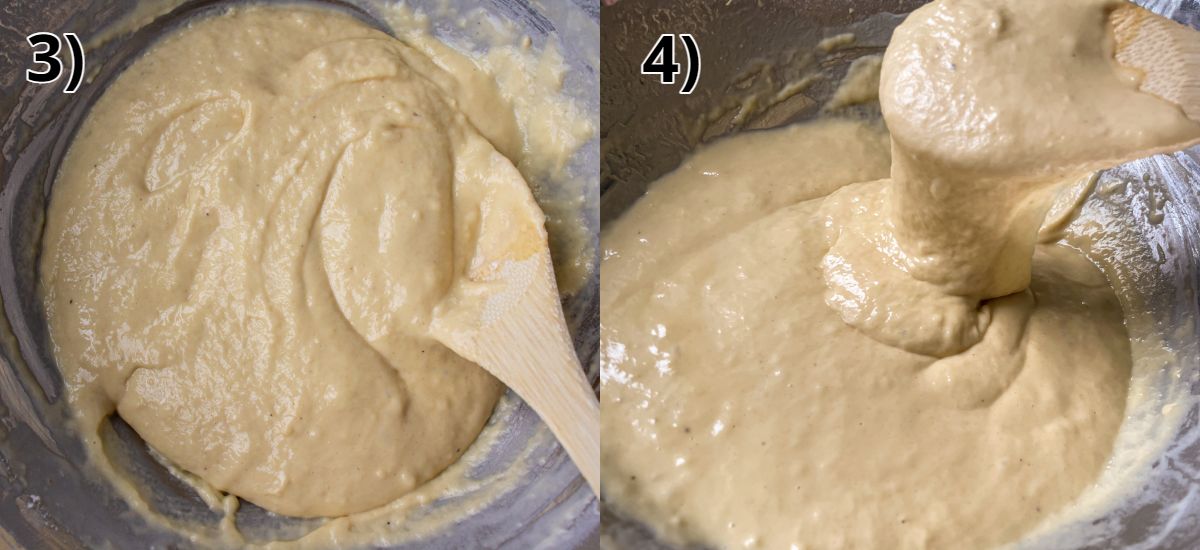Kasnocken (Austrian Spaetzle with Cheese and Onions) are cheesy pasta dumplings topped with onions, and typically prepared in a cast-iron pan. This dish is fun, delicious, and surprisingly easy to make!

Kasnocken is said to originate from Austria’s Pinzgau region and is even sometimes called Pinzgauer Kasnocken. It's particularly common in nearby Salzburg and is a favorite après ski indulgence at Alpine ski huts in the area.
You may already be familiar with the term spaetzle or spätzle, which is what these small pasta dumplings are called in Germany, but in Austria they’re actually called nocken (plural form) or nockerl (diminutive form).
These terms are German versions of the Italian word gnocchi, and basically mean the same thing (small dumplings). Note that these terms can also apply to other styles of dumplings. Meanwhile, käse means cheese in German. So the name kasnocken quite literally means cheese dumplings.
You’ll find a similar dish in Germany called käsespätzle, although that version usually features spaetzle and cheese layered in a casserole and baked. Austrian kasnocken is unique in that it’s cooked in a cast iron skillet. This results in a truly outstanding combination of textures.
Slightly chewy yet tender nuggets of spaetzle or nockerl are offset with a crispy, cheesy crust called the Prinzn. It's the treasured result of letting the dumplings cook, untouched, for several minutes in the hot cast iron pan. Finally, a flourish of fried onions provides a sweet counterbalance to the richness of the dish.
Ingredient notes

- Cheese: The most popular choice of cheese for kasnocken is local to the region where it originates, Pinzgauer Bierkäse (also called weisslacker or beer cheese from different origins). It’s a semi-soft white to light yellow cow’s milk cheese, characterized by a strong odor but mild flavor. You can, however, use other Alpine-style cheeses instead with great results! Though Gruyère and Appenzeller are both Swiss cheeses, they would be great choices in this Austrian dish.
- Note that these cheeses are typically made with animal rennet which means they aren't vegetarian. If you're vegetarian, use a vegetarian cheese instead such as Boar's Head brand vegetarian Gruyère.
- Flour: Use all-purpose (plain) flour to make the batter.
- Milk: You can use any type of milk you have on hand. I only had skim milk in the fridge the day I made this kasnocken, and the results were still fantastic. In a pinch, you can even use water!
- Onion: Use plain brown/yellow onions, or whatever onions you have on hand. No need to get sweet onions for this.

How to make it
In a large mixing bowl, whisk together eggs, milk, salt, pepper, and nutmeg (PHOTOS 1-2).

Stir in the flour, a little at a time, until combined. You want a medium-thick batter. It shouldn’t be too stiff or too runny, and when you lift some up with a spoon it should flow like a ribbon (PHOTOS 3-4). Set aside to rest for 15 to 20 minutes.

Bring a large pot of salted water to a simmer.
You can make the dumplings with either a spaetzle maker or a colander with large holes. Place the spaetzle maker or colander over the pot and fill it with batter (add a little at a time and do this in batches). Use a silicone pastry scraper or spatula to press the batter through the holes, or slide the slider back and forth, to make the dumplings (PHOTOS 5-6).

Cook until all the dumplings float to the surface, about 2 minutes (PHOTO 7). Drain, rinse with cold water (so they don’t stick together), and set aside (PHOTO 8).

In a 10-to-12-inch diameter cast-iron skillet or heavy non-stick skillet, melt half the butter over medium heat. Add the onions and cook, stirring occasionally until soft and browned, about 8 to 10 minutes. Remove to a small plate or bowl.

Add the remaining butter to the skillet and let it melt over medium heat. Add the cooked, cooled dumplings and stir to heat back through (PHOTO 9). Then, add the cheese and stir to thoroughly combine and melt the cheese (PHOTO 10).

Allow the mixture to continue to cook, undisturbed, for about 4 to 5 minutes to create a crust (called the Prinzn) along the bottom and sides of the pan.

Remove from the heat, top kasnocken with the onions and chives and serve immediately.
Please scroll to the bottom of the post for the full recipe (in a printable recipe card) including ingredient amounts and detailed instructions.

Expert tips
Since this is such a rich and hearty meal, traditionally a shot of schnapps is consumed after dining on kasnocken to aid digestion.
When mixing the batter, use a wooden spoon to stir more vigorously after the first couple of additions of flour. This helps to ensure you don't start with any lumps. Then it's much easier to stir in the remaining flour while maintaining a smooth batter.
Although you can use a colander with large holes to make homemade spaetzle, using a dedicated spaetzle maker is easier, generally less messy, and yields better results. You can use a board-type spaetzle maker with a slider that goes back and forth (this is what I use), a pot-style spaetzle maker with a scraper, or even a spaetzle press which will make longer spaetzle noodles rather than small nuggets.
Cook the spaetzle at a simmer instead of a boil. The simmering water is more gentle than a rapid boil, and will still cook the spaetlze in a matter of minutes without thrashing them around inside the pot.

Cast iron really retains the heat so food cooks quickly, but if you use another type of pan the cooking times may be a bit longer than indicated in the recipe to get the same results.
When cooking the onions, keep a closer eye on them toward the end of cooking and lower the heat if needed. They can go from browned to burned quite easily, especially in a hot cast iron pan.
A wooden spatula is great for serving kasnocken! It's thin and sturdy enough to lift up all that beautiful browned cheesy crust, but won't scrape or damage the seasoning of your cast iron pan.

Other recipes you may like
- Krautfleckerl (Austrian Cabbage and Noodles)
- Liptauer (Austrian/Slovakian Cheese Spread)
- Erdäpfelsalat (Austrian Potato Salad)
- Flammkuchen / Tarte Flambée (German Pizza with Bacon and Onions)
- Zwiebelkuchen (German Onion Pie)
- Schinkennudeln (German Ham and Cheese Noodle Casserole)
- Himmel und Erde (German Heaven and Earth Potatoes)
- Schupfnudeln (German Potato Noodles)
- Tartiflette (French Potato, Bacon and Cheese Gratin)
Tried this recipe? Please leave a star ⭐️⭐️⭐️⭐️⭐️ rating in the recipe card below and/or a review in the comments section further down the page. You can also follow me on social media on Facebook, Instagram, and Pinterest!

Kasnocken (Austrian Spaetzle with Cheese and Onions)
Ingredients
Nockerl/Spaetzle:
- 2 large eggs
- ¾ cup milk
- ½ teaspoon kosher salt
- Pinch ground black pepper
- Pinch nutmeg
- 250 grams (2 cups) all-purpose flour
Topping and Finishing:
- 30 grams (2 tablespoons) unsalted butter
- 1 medium onion peeled and thinly sliced
- 175 grams (about 2 ½ cups) shredded cheese such as Bierkäse, Gruyère, or Appenzeller
- Chopped chives for garnish
Instructions
- In a large mixing bowl, whisk together the eggs, milk, salt, pepper, and nutmeg until smooth. Stir in the flour, a little at a time, until combined. You want a medium-thick batter. It shouldn’t be too stiff or too runny, and when you lift some up with a spoon it should flow like a ribbon. Set aside to rest for 15 to 20 minutes.
- Bring a large pot of salted water to a simmer. You can make the dumplings with either a spaetzle maker/scraper or a colander with large holes. Place the spaetzle maker or colander over the pot and fill it with batter (add a little at a time and do this in batches). Use a silicone pastry scraper or spatula to press the batter through the holes, or slide the slider back and forth, to make the dumplings.
- Cook until all the dumplings float to the surface, about 2 minutes. Drain, rinse with cold water (so they don’t stick together), and set aside.
- In a 10-to-12-inch diameter cast-iron skillet or heavy non-stick skillet, melt half the butter over medium heat. Add the onions and cook, stirring occasionally until soft and browned, about 8 to 10 minutes. Remove to a small plate or bowl.
- Add the remaining butter to the skillet and let it melt over medium heat. Add the cooked, cooled dumplings and stir to heat back through. Add the cheese and stir to thoroughly combine and melt the cheese. Roughly smooth out the top and allow the mixture to continue to cook, undisturbed, for about 4 to 5 minutes to create a crust along the bottom and sides of the pan.
- Remove from the heat, top with the onions and chives and serve immediately.
Notes
- Since this is such a rich and hearty meal, traditionally a shot of schnapps is consumed after dining on kasnocken to aid digestion.
- The most popular choice of cheese for kasnocken is local to the region where it originates, Pinzgauer Bierkäse (also called weisslacker or beer cheese from different origins). You can, however, use other Alpine-style cheeses (such as Gruyère or Appenzeller) instead with great results!
- Note that these cheeses are typically made with animal rennet which means they aren't vegetarian. If you're vegetarian, use a vegetarian cheese instead such as Boar's Head brand vegetarian Gruyère.
- When mixing the batter, use a wooden spoon to stir more vigorously after the first couple of additions of flour. This helps to ensure you don't start with any lumps. Then it's much easier to stir in the remaining flour while maintaining a smooth batter.
- Although you can use a colander with large holes to make homemade spaetzle, using a dedicated spaetzle maker is easier, generally less messy, and yields better results. You can use a board-type spaetzle maker with a slider that goes back and forth (this is what I use), a pot-style spaetzle maker with a scraper, or even a spaetzle press which will make longer spaetzle noodles rather than small nuggets.
- Cook the spaetzle at a simmer instead of a boil. The simmering water is more gentle than a rapid boil, and will still cook the spaetlze in a matter of minutes without thrashing them around inside the pot.
- When cooking the onions, keep a closer eye on them toward the end of cooking and lower the heat if needed. They can go from browned to burned quite easily, especially in a hot cast iron pan.
- A wooden spatula is great for serving kasnocken! It's thin and sturdy enough to lift up all that beautiful browned cheesy crust, but won't scrape or damage the seasoning of your cast iron pan.
Nutrition
*All nutritional information is based on third-party calculations and should be considered estimates. Actual nutritional content will vary with brands used, measuring methods, portion sizes and more.*






Karin says
I am from Austria and I really love the description of preparing the Kasnocken, and using the correct words for it 🙂